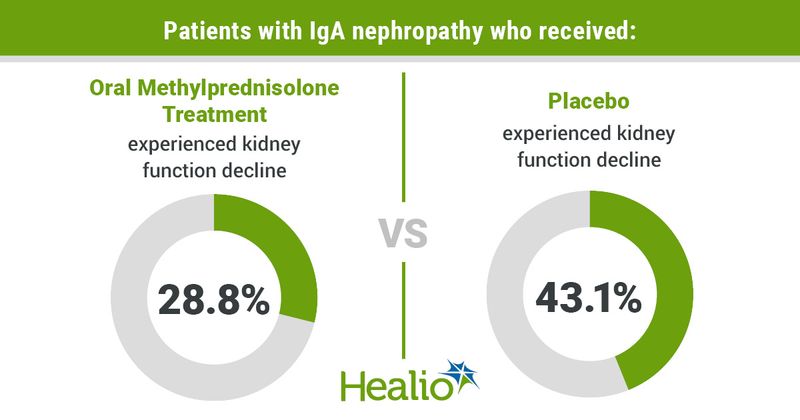Oral methylprednisolone treatment reduces risk of kidney function decline vs. placebo
Compared with placebo, oral methylprednisolone treatment reduced the risk of kidney function decline among patients with IgA nephropathy at high risk of progression, according to data published in JAMA.
However, investigators found serious adverse events correlated with high-dose oral methylprednisolone.

“Although there have been advances in understanding the pathogenesis of IgA nephropathy, highlighting its immunological basis, no disease-specific therapy has been proven to prevent kidney failure,” Jicheng Lv, MD, from the renal division in the department of medicine at Peking University First Hospital in Beijing and colleagues wrote. They added, “The Therapeutic Effects of Steroids in IgA Nephropathy Global (TESTING) study was designed to determine the effects of oral methylprednisolone on the risk of major kidney outcomes, as well as adverse effects, in people with IgA nephropathy and proteinuria.”
In an international, multicenter, double-blind, randomized clinical trial, researchers examined 503 patients (mean age was 38 years; 39% were women) with IgA nephropathy, proteinuria greater than or equal to 1 g per day and eGFR of 20 mL/min/1.73 m² to 120 mL/min/1.73 m² following at least 3 months of “optimized background care.” All patients received care from one of 67 centers in Australia, Canada, China, India and Malaysia between May 2012 and November 2019. Researchers followed up on patients until June 2021.
Researchers randomized patients in a 1:1 ratio to receive either oral methylprednisolone (n=136) or placebo (n=126). After randomization, researchers identified an excess of serious infections among patients and reduced oral methylprednisolone doses from 0.6 mg/kg per day to 0.8 mg/kg per day, maximum 48 mg per day, weaning by 8 mg per day per month to 0.4 mg/kg per day, maximum 32 mg per day, weaning by 4 mg per day per month. In addition to the dose reduction, researchers gave subsequent patients antibiotic prophylaxis for pneumocystis pneumonia (121 in the oral methylprednisolone group and 120 in the placebo group).
Using an adjusted Cox model, researchers determined the effect of treatment on the primary end point of a composite of 40% decline in eGFR, kidney failure or kidney disease-related death. Similarly, the Kaplan-Meier method created survival curves.
Analyses revealed the primary end point occurred in 28.8% of the methylprednisolone group and 43.1% in the placebo group. Among the 503 patients, 493 completed the trial. Both doses of methylprednisolone reduced risk of kidney function decline, but more serious adverse events correlated with the intervention than placebo (10.9% vs. 2.8%); the occurrence of serious adverse events increased as the dosage increased (16.2% vs. 3.2%).
“The observed kidney benefits showed no significant heterogeneity of treatment effect between a reduced-dose regimen and the original full-dose protocol. However, the incidence of serious adverse events was increased with oral methylprednisolone and the reduced-dose regimen had fewer adverse events compared with the full-dose regimen,” Lv and colleagues wrote. “Overall, these data suggest that a 6- to 9-month course of oral corticosteroids effectively protected kidney function in people with IgA nephropathy and that this benefit can be realized with a reduced-dose protocol with a lower risk of adverse events.”
